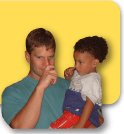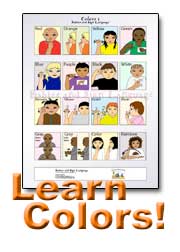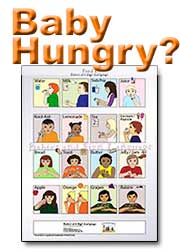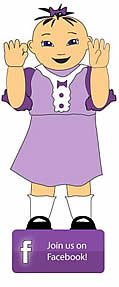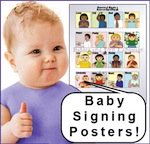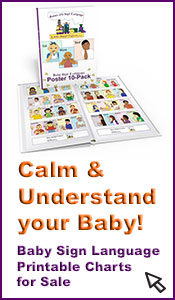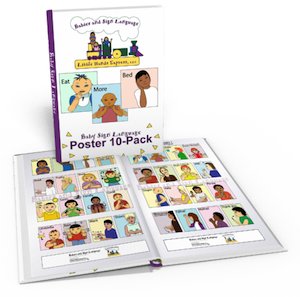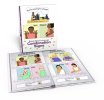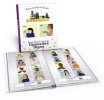Potty Training Made Easy Using Baby Signs
by Linda Acredolo, Ph.D.,
(Vacaville, CA, USA)
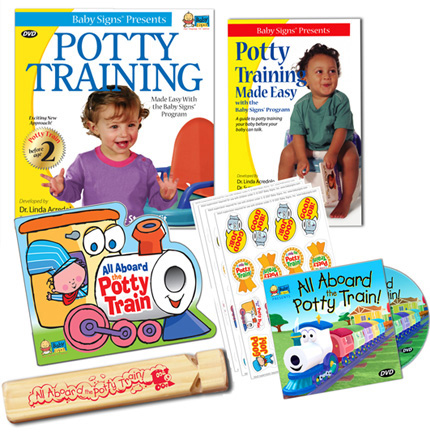
Baby Signs® Potty Training Kit
What's It All About?
By Linda Acredolo, Ph.D., and Susan Goodwyn, Ph.D.
The Problem with Potty Training Today
Believe it or not, the average age at which American parents potty train their babies is higher than at any time in history—37 to 38 months. And that is just the average—many 3 ½ and even 4-year-olds are still in diapers.
Why?
Because parents today have been led
to believe that it is easier and healthier to potty train their babies if they wait until their child is ready—typically age 2 ½ to 3 or even later.
Until the late 1950s, American children were potty trained by 12 to 18 months. Why the dramatic change over the last 50 years? The answer is simple: The introduction of the disposable diaper in the early 1960s made it possible for parents to avoid the more labor intensive cloth diaper, and in doing so, removed a major incentive to complete potty training as soon as possible.
At the same time, diaper companies actively promoted a “modern approach” to potty training whereby parents were advised to wait to start training until their child was “ready”—with readiness defined as wanting to be trained and being able to communicate effectively.
And now, with the creation of Size 7 diapers for children over 41 pounds, parents are beginning to postpone potty training even longer. The results of these changes are higher frustration levels for parents and children—as well as higher profits for the diaper companies.
The fact is that both historical and cross-cultural data indicate that children train when parents expect them to train.
Even the American Academy of Pediatrics (AAP) agrees that the trend towards later and later training is result of parental expectations rather than necessity:
“The truth is that most popular assumptions about the best age to toilet-train— in this and most other countries—depend more on the adults’ needs, desires, and cultural attitudes than on a typical child’s readiness to control her bodily functions.” (AAP Guide to Toilet Training, 2003, p. 6)
The Big Myth About Late Training
Today’s parents have been led to believe, mistakenly, that older children are easier to train than younger children. Unfortunately, by following the advice to postpone training, parents are unknowingly setting themselves up for unnecessary power struggles.
In reality, potty training a baby under the age of 24 months is actually easier than potty training an older child. Here’s what parents of 2-, 3-, and 4-year-olds are up against:
Increased Oppositional Behavior
Late potty training is more likely to result in a “battle of wills” between child and parent due to the rise in oppositional behavior after age 2. These are battles parents can’t win because children cannot be made to poop or pee on command.
As the AAP warns,
“This resistance can create more frustration and even anger on the part of the parents, whose increasingly negative responses lead to more resistance and outright rebellion in an ever-escalating cycle.” (AAP Guide to Toilet Training, 2003, p. 71)
A Well-Ingrained Habit
The longer a habit has been in place, the harder it is to break. In the case of potty training, 3- and 4-year-olds have been going in their diapers all their lives— that’s all they know. It’s hardly surprising that there’s a reluctance to change something so fundamental.
The Rise of Shame and Embarrassment
Starting about age 2, children develop the ability to feel embarrassment. Eliminating into a diaper, as they are used to doing, is a very private matter. In contrast, using the potty is not only novel, but much more public.
Feelings of shame are particularly common in regards to bowel movements, with high proportions of late trained children these days resorting to hiding when they need to go or withholding bowel movements to the point of serious constipation.
Development of Vivid Imaginations
The ability to imagine things in their minds also increases dramatically after age 2, a new skill that, unfortunately, enables children to imagine scary things as well as positive things.
That’s why we typically see an increase in common childhood fears among 2-, 3-, and 4-yearolds— including toilet-related fears. Children who are afraid of things like the “toilet monster” or the flushing sound are, understandably, harder to persuade.
Emotional Consequences of Late-Training
Late potty training can also result in long-term negative feelings. Intense power struggles, for example, can color how parents view their child in the future, thereby endangering the parent-child relationship.
In addition, children who stay in diapers too long can develop feelings of shame and low self-esteem as a result of negative messages from desperate parents and mocking peers (e.g., “only babies wear diapers,” not “big kids”). They are also much more likely than younger children to be embarrassed by accidents.
The American Academy of Pediatrics agrees.
In talking about the hazards of training older children they warn:
“A child’s ability to act on his own spurs resistance to a parent’s directions. A preschooler’s improved verbal skills allow him to argue and negotiate. His awareness of other children’s behavior may backfire if he feels ashamed of his continued diaper use. The simple force of long habit can also make it more difficult to achieve the transition out of diapers.”
—AAP Guide to Toilet Training (2003, p. 91)
The Solution: The Baby Signs® Potty Training Program
By bringing the power of signing to the task of potty training, the Baby Signs® Potty Training Program makes it possible—and easy—for parents to avoid the hazards that late training engenders and complete potty training before their child’s 2nd birthday.
Why signs? Because with the help of five simple potty-time signs, babies can reach communication readiness well before they learn to talk.
Advantages of the Baby Sign Language Potty Program
1. Easier For Parents
By beginning potty training before age 2, parents are tapping into a period of development when toddlers are still relatively complaint rather than actively defiant, that is, before the proverbial “terrible twos” set in.
Younger toddlers are also more content to sit still, especially when a parent is there with a book, song, or game to make the wait fun.
And of course, the Baby Signs® Potty Training Program makes it easier for parents to train their babies because it give babies a way to communicate even before they can talk. It gives them a way to tell parents when they have to go potty.
2. Fun for Babies
The Baby Signs® Potty Training Program provides parents with the resource they need to make potty training simple and fun. In addition to a step-by-step guide for parents, the Baby Signs® Potty Training Kit comes with a full set of fun and motivational products babies will love – all designed to make them eager to “get on board the Potty Train.”
An illustrated board book, full-length DVD, conductor’s whistle and rewards stickers all work together to make potty time both fun and successful. Additional motivational
tools are available free at PottyTrainWithBabySigns . com .
3. Good for Babies’ Development
The Baby Signs® Potty Training Program not only helps babies reach toileting independence earlier, it also gives them the benefits of signing. Over two decades of scientific research, much of it funded by the National Institutes of Health, has shown that the Baby Signs® Program:
• reduces frustration and aggressive behaviors
• builds trust between babies and their parents
• promotes positive emotional development
• boosts babies’ self-confidence and builds self-esteem
• helps babies learn to talk
• boosts babies’ intellectual development
4. Good for the Environment
Children who are trained by age 2 will use between 1000 and 4000 fewer diapers! Here’s why that’s important:
• In the year 2006 alone, over 7.25 billion pounds of disposable diapers went into U.S.landfills.
• It can take up to 500 years for one disposable diaper to decompose in a landfill—if it ever does.
• Even so-called biodegradable disposables often don’t decompose in landfills as they are designed to do because they don’t receive the oxygen necessary for decomposition.
• Cloth diapers aren’t the solution because they have their own environmental costs, especially in water. Many argue it’s a “draw.”
5. Good for Family Budgets!
Getting their babies out of diapers by age 2 will save families money that can definitely be put to better use.
For more information visit:
pottytrainwithbabysigns.com
Watch a video about the program:
pottytrainwithbabysigns.com/pro_v.html
Potty Train Your Baby Before Age 2 With Baby Signs

